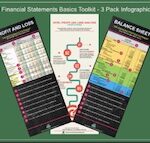Financial Performance Analysis-5 Step System You Cannot Do Without
Is your financial performance analysis decision focused and results driven?
Dangerous consequences can happen for managers who use a hit or miss approach to analysis & decision making.
This results in failed decisions and loss of credibility.
I will introduce you to a proven process for analyzing financial performance.
And taking decisions based on that analysis.
In fact, it is an entire system which produces success consistently.
Want that?
Grab this EXCEL Spreadsheet
Don’t miss our 5 Killer Hotel KPIs Dashboard
Get this exclusive Excel Template that you can customize to create your own 5 Killer Hotel KPIs Dashboard
Let's go!
This blog post will cover the 5 steps that will elevate the success levels of your decision making:
- Discover RELATIONSHIPS in Financial Performance Analysis
- Identify TRIGGERS of financial performance
- Determine CAUSE EFFECT of financial performance
- Target Cause in Financial Decisions
- Measure Financial Results of Actions
What is Your Approach to Financial Performance Analysis?
How do you conduct financial analysis and take decisions?
Do you have a proven process for taking decisions in your business toolkit?
As an aspiring hotel general manager, decisions must be occupying a major part of your responsibilities.
It is imperative therefore that you have in place a process which you can rely on for strategies and decisions.
Unfortunately many hotel managers do not provide a sold foundation to their decisions.
Decisions are often hit or miss.
This results in disappointments as decisions fail and you lose credibility.
What if I told you that there is a proven system of decision making which guarantees results?
Based on effective financial performance analysis.
Let us get to it.
SHARE Infographic.
Coming Soon: The Ultimate Financial Skills Building Infographic Hub.....
5 Step Financial Performance Analysis System
The 5 Step Financial Performance Analysis System leverages some of the most powerful principles of financial statement analysis.
It begins with a premise often not realized by hotel managers.
That the power in analysis from a Profit and Loss Statement comes from relationships within it.
We are using the Profit and Loss Statement as an example since it is often known as the performance statement.
However, the application of the relationships principle is to all financial statements and indeed to all analysis.
Let us dive straight into the first of the 5 Steps.
Discover Relationships in Financial Performance Analysis
Powerful analysis is less about looking at individual elements in a financial statement.
It is about first looking at the forest rather than the trees.
You must cultivate this practice in your business toolkit.
It is stepping back and taking a big picture overview.
Unfortunately, too many managers get too close to the analysis.
They cannot see the interaction of elements like revenue, expense, profit, asset, liabilities and so on.
Profit and Loss Statement being the performance statement also carries these relationships.
However, two major defects underline the problem a manager faces when analyzing a profit and loss statement.
- Profit and Loss Statement does not show relationships between revenues and expenses beyond variances
- Profit and Loss Statement does not show behavior of expenses vis-a-vis revenues
The pain from these huge shortcomings is almost paralyzing.
For example, say you are looking at revenue performance.
If you do not see relationships of revenue with say the asset that produces the revenue, you are missing a huge factor.
A factor which may well explain the result or lack of it.
This is the reason why in the hotel rooms revenue sphere, occupancy and average daily rate are important KPIs.
But they do not provide a perspective that say, RevPAR can provide.
RevPAR tells you the relationship between room revenue and rooms available.
Rooms Available is the asset that is producing the room revenue.
Apart from this, RevPAR takes into account both occupancy and average daily rate.
So, it is leveraging the relationship of business volume (occupancy) with price (average daily rate).
This is based on a universal principle .
That any changes in average daily rate will impact occupancy and the other way around most times.
So, when revenue performance is looked at, it is critical that all relationships with that revenue element are considered.
Thus, discovering relationships between elements of financial statements is the first step in the 5 Step Financial Performance Analysis System.
Identify Triggers in Financial Performance Analysis
Having discovered various relationships that exist between elements, the next step is to identify triggers.
What are triggers?
Triggers are elements of financial statements that affect other elements.
These elements are often called Key Performance Indicators or KPIs.
Some KPIs cause other KPIs to change.
You could say that a KPI could be triggering another KPI.
In the example in the first step we looked at RevPAR and its relationship with room revenue.
Now, we can say that RevPAR is the KPI that triggers room revenue.
Further we saw that RevPAR is itself triggered by three other KPIs:
- occupancy,
- average daily rate and
- rooms available.
Triggers bring out one of the most powerful concepts in analysis.
They differentiate between Cause and Effect.
Cause is the reason something is happening.
Effect is the result that is happening.
In our example, occupancy, average daily rate and rooms available separately and together as RevPAR are the Cause.
The Effect in our example is room revenue.
Why is this such a big deal?
Well, it is a big deal because you need to be focusing on cause in your actions and decisions.
Not the Effect.
This is often something that hotel managers miss.
They take decisions based on what their Profit and Loss Statement is showing as revenue, expenses and profit.
Without going into the cause.
That will end up in a failed decision.
In other words, let us say hotel managers take decisions based on just what the room revenue variance is showing.
Without drilling down into the cause elements (occupancy, average daily rate, rooms available etc), that action is doomed to fail.
Thus, triggers show you which is cause and which effect in relationships of analysis.
And now on to possibly the most powerful of the 5 Step Financial Performance Analysis System.
Determine Cause Effect of Financial Performance
In the earlier step, we identified triggers, often KPIs.
We were also introduced to cause and effect.
In this step, you will actually take the step of finding out which is the cause and which effect.
In any analysis.
For example, let us say room revenue is falling or stalling despite growth in the market.
In this step, the decrease in the room revenue is the Effect.
You must investigate the Cause.
Is it occupancy or average daily rate which are causing decreased room revenue?
Remember, the example says market is showing growth.
That means that something is causing the room revenue to fall against the market behavior.
Cause could be higher prices.
Customers often have price resistance.
A price deemed higher than the value provided is not acceptable.
If price is the one causing occupancy to drop thereby lowering room revenue, then further cause needs to be searched out.
Is it any particular market segment that is causing the fall?
And so on.
It is critical to understand a couple of things
- Decisions and Action cannot be based on Effect
- Cause needs to be dug out from the hotel operation
RevPAR is a great example of how multiple KPIs could be triggering the effect.
You need to carry out this step in a focused way.
Why is that you ask?
Well, so that you can take the next 4th step successfully, as in results driven.
What is the 4th step you ask?
Let us get right to the 4th step now.
Target Cause in Financial Decisions
In a way, in the these first three steps, you have set up the situation for taking action or the decision.
Out of that preparatory work you carried out, you need to separate the cause.
Why you ask?
Because you want to target cause in your financial decision making.
Targeting cause is critical in results driven decisions.
How can you take a decision to remedy something without understanding cause?
In our example, you cannot take any kind of meaningful action or decision just knowing that your room revenue is decreasing.
You need to figure out if occupancy, average daily rate, rooms available or any other factor is causing the lower room revenue.
And how much?
Because the goal of your decision is to remedy the situation.
This may be arresting the fall, or even reversing the trend and causing room revenue to grow.
But all that will depend on what specific cause you have zeroed in on.
Many managers use the effect in their decisions for remedy.
In our example, taking decisions based on just the negative room revenue variance.
Remember, variances are just a symptom.
Variances are mere indicators.
What you should be focusing on is the cause - why room revenue is falling when the market is growing?
You may often be wondering why some of your decisions seemed to produce no or even negative results!
It is a good bet that you may have used effect or symptom to take decisions.
And now on to the 5th and an important step in our 5 Step Financial Performance Analysis system.
Measure Financial Results of Action
Peter Drucker, the Father of Management once said: "You cannot improve what you do not measure."
And so it is that we must take this 5th step seriously.
Having taken action and a decision in Step 4 based on groundwork done in the first 3 steps, you are now ready for this step 5.
You will measure the financial results of your decision taken.
What action did you take to arrest or reverse room revenue decrease?
What were the results?
Did the result arrest the decrease?
What went right?
What did not go right?
How can you take stock and course correct.
Step 5 is an iterative process.
It is a Rinse and Repeat process.
Your Takeaways
One could conclude from our discussion that the success of financial performance management is entirely dependent on the 5 Step System.
What kind of decision framework do you have in your business toolkit?
Do you look at relationships, triggers, cause and effect before taking decisions?
How successful or otherwise have your decisions been in the past.
Related Posts
Sign Up for More Tips, Strategies and Secrets
15






